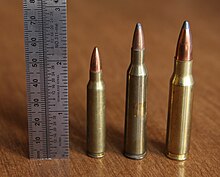.220 Swift
| .220 Swift | ||||||||||||||||||||
|---|---|---|---|---|---|---|---|---|---|---|---|---|---|---|---|---|---|---|---|---|

|
||||||||||||||||||||
| Type | Rifle | |||||||||||||||||||
| Place of origin | United States | |||||||||||||||||||
| Production history | ||||||||||||||||||||
| Designer | Winchester | |||||||||||||||||||
| Designed | 1935 | |||||||||||||||||||
| Manufacturer | Winchester | |||||||||||||||||||
| Produced | 1935 | |||||||||||||||||||
| Variants | Wilson-Wotkyns .220 Arrow | |||||||||||||||||||
| Specifications | ||||||||||||||||||||
| Parent case | 6mm Lee Navy | |||||||||||||||||||
| Case type | Semi-rimmed, bottleneck | |||||||||||||||||||
| Bullet diameter | .224 in (5.7 mm) | |||||||||||||||||||
| Neck diameter | .260 in (6.6 mm) | |||||||||||||||||||
| Shoulder diameter | .402 in (10.2 mm) | |||||||||||||||||||
| Base diameter | .445 in (11.3 mm) | |||||||||||||||||||
| Rim diameter | .473 in (12.0 mm) | |||||||||||||||||||
| Case length | 2.205 in (56.0 mm) | |||||||||||||||||||
| Overall length | 2.680, 2.580 H.P. Bullets | |||||||||||||||||||
| Case capacity | 47 gr H2O (3.0 cm3) | |||||||||||||||||||
| Rifling twist | 1 in 14–16 in (360–410 mm) | |||||||||||||||||||
| Primer type | Large rifle | |||||||||||||||||||
| Maximum pressure | 62,000 psi (430 MPa) | |||||||||||||||||||
| Ballistic performance | ||||||||||||||||||||
|
||||||||||||||||||||
| Source(s): Hodgdon | ||||||||||||||||||||
The .220 Swift (5.56×56mmSR) is a semi-rimmed rifle cartridge developed by Winchester and introduced in 1935. It was the first factory loaded rifle cartridge with a muzzle velocity of over 4,000 ft/s (1,200 m/s). The .220 Swift remains the fastest commercial cartridge in the world, with a published velocity of 4,665 ft/s (1,422 m/s) using a 29 grain bullet and 42 grains of 3031 powder.
The Swift is a large cased .224 caliber cartridge and bullet that was created for small game such as prairie dogs, groundhogs and other vermin (or "varmints" in the US) such as marmots. Upon its introduction it astounded the varmint hunting world by being fully 1,400 ft/s (430 m/s) faster than its nearest competitor, which was the .22 Hornet (also .224 caliber). It was found to be an extremely accurate cartridge as well.
Due to its very high velocity its bullet drop allows dead on sighting on game such as groundhogs to ranges out to 375 yd (343 m), and it is still considered an excellent cartridge for taking varmints by experienced Swift shooters.
The original factory load from Winchester provided a 48-grain (3.1 g) bullet launched at 4,100 feet per second (1,250 m/s). Handloaders could marginally improve on this but only at maximum loads. The Swift can be loaded with light bullets to reach 4,400 ft/s (1,300 m/s). In recent times 75-grain (4.9 g) .224" bullets have been developed for use in high velocity .22 caliber rifles for taking larger game and long-distance shooting. Heavier bullets perform best in rifles that have an appropriate rifling twist rate taking into consideration the diameter, length, and other physical properties of the projectile.
The prototype for the .220 Swift was developed in 1934–35 by Grosvenor Wotkyns who necked down the .250-3000 Savage as a means of achieving very high velocities. However the final commercial version developed by Winchester is based on the 6mm Lee Navy cartridge necked down. The .220 Swift was developed by Winchester and introduced in 1935 as a new caliber for their Model 54 bolt-action rifle. When the Winchester Model 70 bolt action was first issued in 1936, the .220 Swift was one of the standard calibers offered and continued to be until 1964 when it was discontinued.
...
Wikipedia
